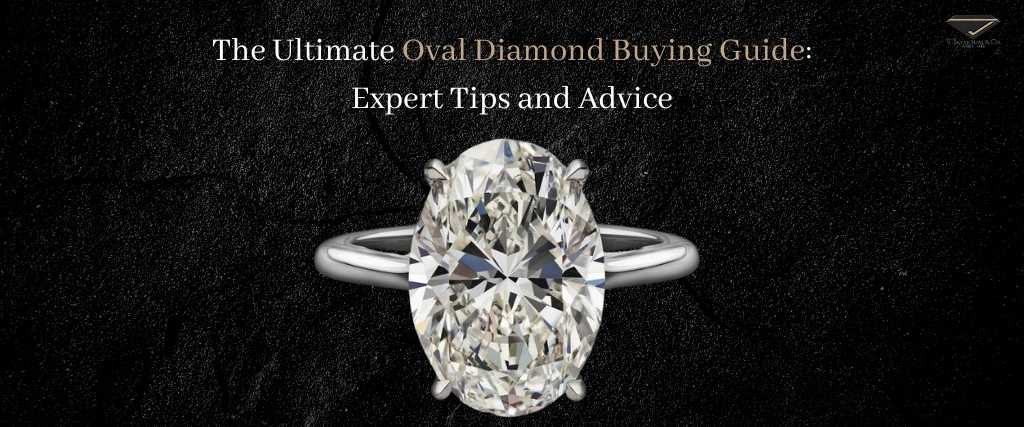
An oval-cut diamond provides outstanding brilliance, durability, and style. However, it’s crucial to be mindful of the ‘bow tie effect’ in oval diamonds, a potential dark area in the diamond’s center.
You will receive the greatest oval-cut diamond for your money if you adhere to the suggestions we have provided in this post. Oval diamonds seem bigger than their true carat weight and can cost less than round diamonds because of their peculiar form and unique combination of traditional round brilliance. Their extended shape gives conventional diamond cuts a contemporary twist in addition to improving the attractiveness of the finger. Everything you need to know will be covered in this post to help you choose the ideal oval diamond buying guide for your desired style.
A diamond with an oval cut is magnificent and one of a kind, bursting with fire and sparkle. The oval is a "fancy" form that seems bigger than other shapes of the same carat weight due to its elongated design. The oval diamond's thin body gives it an extended appearance. It gives the hand and fingers a thinner appearance. The diamond is less likely to chip as it doesn't have any sharp corners. An oval diamond is a great alternative if you like round designs but want a stone with more personality. Additionally, oval diamonds often cost less than round brilliants.
Oval diamonds with a length-to-width ratio of 1.35 to 1.50 are regarded as ideal. Most websites will perform the calculation for you, but it is done by dividing the diamond's length by its width.
Avoid exceeding the 1.50 ratio to avoid having a skinny-looking stone that will reduce the stone's luster. Avoid stones below the 1.35 L/W ratio as well, since they will seem stubby.
Whether one chooses a longer or rounder appearance depends on personal choice. You may view examples of completed rings at the following website. Use this to contrast the appearance of a mounted rounder or longer oval diamond.
The beauty of an oval-cut diamond is subjective. An oval diamond’s table and depth % influence its brilliance, or how brightly it glows and sparkles. The table is the flat surface on top of the diamond, and the depth represents the thickness of the diamond.
Oval diamonds with an ideal cut will have a depth percentage of 57 to 63% and a table percentage of 53 to 63%. The table percentage calculates how big the table is in relation to the diamond's overall top surface.
Remember that carats measure weight and not size. When you are just beginning your search for an oval-cut diamond, using carat weight is a good and simple way to narrow down your choices. However, as you become a bit more savvy and are closer to making an actual purchase, you want to compare the sizes of the diamonds you are considering by looking at their measurements.
However, you always want to take a second look to make sure that the diamond you are selecting as your final choice has measurements that are average to above average for its carat weight.
Remember that carats measure weight and not size. When you are just beginning your search for an oval-cut diamond, using carat weight is a good and simple way to narrow down your choices. However, as you become a bit more savvy and are closer to making an actual purchase, you want to compare the sizes of the diamonds you are considering by looking at their measurements.
However, you always want to take a second look to make sure that the diamond you are selecting as your final choice has measurements that are average to above average for its carat weight.
Oval diamonds are good at hiding color because of their cut. Due to its outstanding faceting pattern, you may dip down on the color spectrum and still have a gorgeous diamond. If you don’t have a specific budget, then the D-G colorless grades are one of the best possibilities. The less color a diamond has, the better; the D-G colorless grades have amazing fire and brilliance. However, you have additional choices, such as diamonds in the colors M, H, and K.
As a result, you can easily find a stunning oval-cut diamond without having to choose a high-clarity diamond. Diamonds with high-clarity grades are much more expensive than low-clarity ones. Therefore, you can easily save some money by moving lower on the grade of clarity without compromising on the magnificence of the stone.
An oval cut stone must be symmetrical. An oval diamond not only has an identical side but also perfectly rounded edges that gracefully slope towards the ends. One of the biggest concerns with an oval-cut diamond is that even the slightest amount of disproportion is extremely visible. One of the best oval diamond buying guides is to purchase it from a well-known expert, as it takes a very high amount of skill to craft out a perfectly symmetrical shape.
Due to their adaptability, oval-cut diamonds may be used in virtually any setting.
In order to effectively display the form of an oval-cut diamond, settings should often contain four or six prongs. Bezel settings for oval-cut diamonds may also look stunning. Certain oval diamond engagement rings, especially those with three or five stones, have four or six prongs for the center stone in addition to a bezel setting to hold the side stones.
An oval-cut diamond ring may be created in practically any setting, from vintage to side stone, in terms of fashion. But in certain fashions, oval diamonds appear very stunning. The ideal settings are shown below, along with ideas for engagement rings (you may mix the oval with even more styles when creating your own engagement ring).
A sparkling halo of small diamonds makes an oval cut radiate even more. No matter the carat weight, the Oval diamond halo engagement ring is very distinctive.
The classic, simple style of a solitaire setting lets the oval take center stage. A solitaire ring never goes out of style, whether it is made of rose gold or yellow gold.
The extra sparkle elevates the oval shape, whether it's an oval-shaped ring with three stones or a setting with many stones.
Any oval-cut diamond is given more personality and shine by a pavé ring. The designs range from twisted bands to pavé oval diamond rings in the form of solitaires.
Let's look at some of the explanations for why so many people favor oval-cut diamonds.
The oval cut is among the brightest cuts available and one of the most impressive in terms of brilliance and sparkle.
The oval-cut diamond's long shape makes for an elegant-looking ring as well as slimming effects on the wearer's fingers.
The oval diamond is an excellent choice if you are looking for a stunning diamond at an affordable price range along with a high level of brilliance and sparkle.
Although the oval cut is one of my favorites, there are a couple of drawbacks you should be aware of.
Light is not spread evenly inside an oval diamond because of its interior cut. As a result, the stone's center may take on the appearance of a bow tie.
Even though these "bow ties" are typically quite subtle, they are present in most oval-cut diamonds, so it is important to make sure that they won't be a problem for you before making a purchase.
When it comes to faults, blemishes, and inclusions, oval-cut diamonds are less forgiving than round-cut diamonds, so you'll need to spend more money on a stone with a better clarity grade. Fortunately, you may spend more of your cash on a diamond with better clarity because the oval diamond is less expensive.
The oval-cut diamond's curving form and lack of sharp edges make it ideal for people who lead active lives. A beautiful oval diamond with a lot of sparkle and fire also has a particular personality. If you want a beautiful style with a distinctive flare and outstanding durability, think about buying an oval-cut diamond.
If you’re looking to purchase an oval-cut diamond, V. Jayantilal & Co. is the best company to buy oval-cut diamonds at an affordable price.
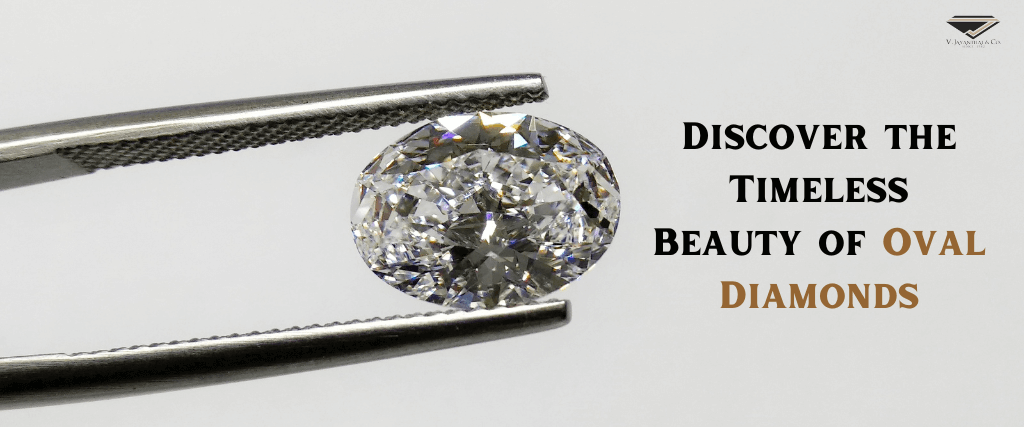
One of those timeless cuts, The Oval diamond, needs little introduction. Similar to the Round diamond, it is capable of speaking for itself and persuading many customers that it is the best option for them. Contrary to the round, it's a fantastic form to take into account if you want to deviate from "the norm" without going too far in the other direction. An oval diamond features an extended round form with a unique twist on understated beauty. Its fire may equal that of a round brilliant when it is faceted in a brilliant manner. The most typical facet configuration for an oval diamond is eight bezel facets on the crown and eight primary facets on the pavilion.
Oval diamonds are popular with many individuals for the following persuasive reasons: Oval diamonds might look bigger to the eye than round diamonds of the same carat weight because they have a larger surface area. The finger may appear longer due to the oval shape. In addition, because an oval diamond lacks sharp angles or corners, it is less likely to chip than other exquisite shapes. Obviously, there’s a lot more to know about the Oval cut than that, but extolling the virtues of this classic cut is certainly a great place to start.
One of the earliest types of diamonds is the oval. Lazare Kaplan, a Russian diamond cutter, improved the form in the 1960s. For the most dazzling, full-of-fire oval-cut diamond, he invented the cutting technique still in use today. Before designing the Modern Oval Cut, Kaplan gained a reputation for his extraordinary talents in cleaving, a procedure in which fractured or terribly defective diamonds are cut into smaller, minimally included gems. Inarguably one of the best-known diamonds in the world, the Koh-I-Noor, or ‘mountain of light, has featured an Oval cut since the mid-nineteenth century. Weighing 105.602 carats, the diamond is now in the possession of Queen Elizabeth II and resides in the Tower of London. Thousands of people have flocked to see it and the incredible glitter that the Oval cut offers throughout the years.
There are several options for settings for engagement rings with oval diamonds. And any option can provide a noticeably distinct appearance. Here are some options.
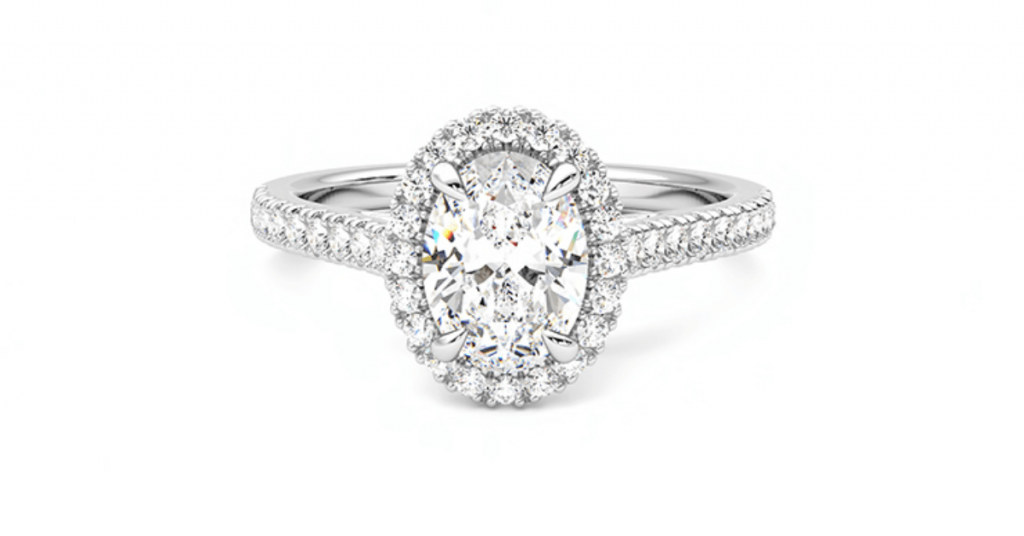
The circular centre stone is surrounded by a stunning halo of lesser diamonds. It draws attention to the form and gives the diamond a bigger appearance. A striking appearance may be achieved by selecting a unique metal colour or side stone.
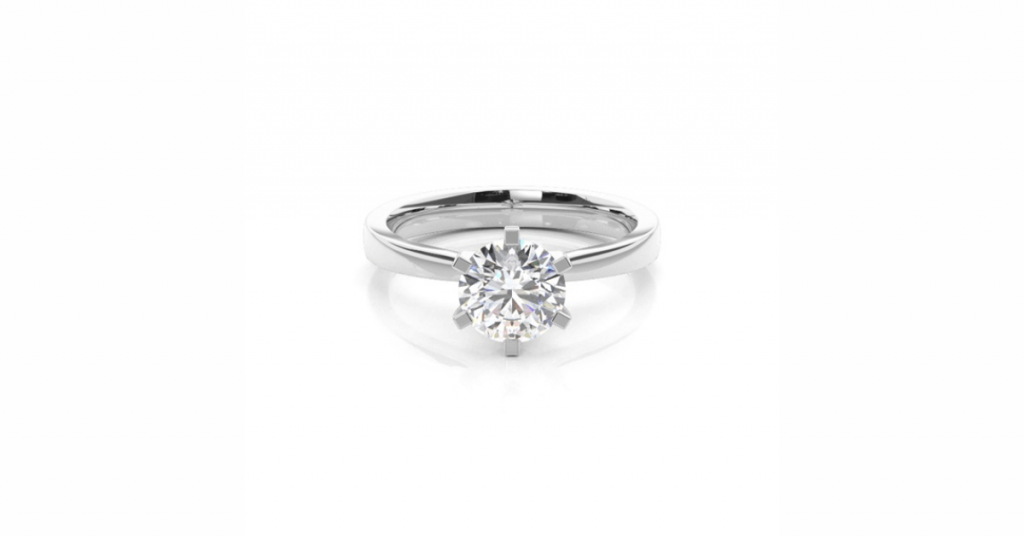
A decent setting for an oval diamond is a prong setting. They not only shield the diamond from damage, but they may also provide height, lifting the stone above the band and catching the viewer's attention.

If you lead an active lifestyle, a bezel setting, which entirely encloses the diamond's edge in metal, is an excellent option. It’s an effective way to protect the diamond and also enhances the beauty of the oval shape.
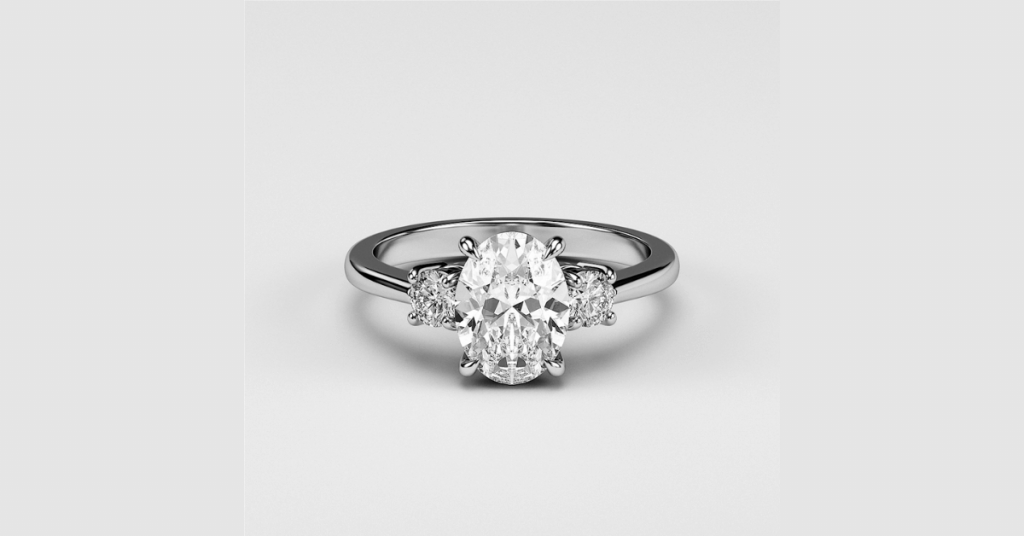
Almost any side stone looks good with an oval diamond. Its form is echoed by half-moon diamonds, which makes them a desirable option. Baguettes and tapering baguettes, as well as coloured gems, provide a chance to establish contrast. Choose side stones that are within one or two colour grades of the main diamond to avoid competing with its beauty if you want your diamond side stones to complement the centre oval.
The most accurate determinant of a diamond's brilliance, brightness, and overall beauty is its cut, which is the most crucial C of all.
The GIA does not assign oval diamonds the same overall cut grade as it does round brilliants, like all fancy cut diamonds. But all is not lost, since there are many more statistics that may be used to describe a diamond's cut. See our table below for a starting point for cut quality.
Remember that although though statistics are an excellent place to start to weed out low-quality diamonds, your best chance is always to see a diamond in person or on video and work with a reputable jeweller to locate the finest quality diamond in your price range. Oval diamonds are particularly arbitrary, and beauty is genuinely in the eye of the beholder (rather than the numbers).
Oval cut diamonds show color more than other diamond shapes, so you'll want to opt for a higher color grade to get a certain look - whether that be cool and colorless or sunny champagne. The larger the diamond, the more obvious the color differences will be.
However, the distinctions between two (or even three) colour classes are frequently indiscernible to the unaided eye, so put your attention on choosing the diamond colour that you adore visually rather than spending more money for a barely noticeable letter grade.
Carat refers to a diamond's weight and not its size as many people believe. Thanks to their elongated shape, oval cut diamonds tend to look bigger for their carat weight vs other diamond shapes like a round cut diamond.
While sizes vary depending on how a stone is cut, a one-carat round diamond usually measures 6.5 x 6.5 mm, whereas an average oval cut diamond is usually 7.7 x 5.7mm - the extra height provides the impression that it is bigger. Therefore, think about an oval cut if you want a diamond that appears larger than its actual carat weight.
The quantity of imperfections or flaws in a diamond is referred to as clarity. The oval shape and superb cutting help oval-cut diamonds to effectively conceal flaws. This implies that you may choose a diamond with a lesser clarity grade and yet have it be eye-clean. Now you're free to spend your budget on more important factors, like cuts.
Remember that imperfections closer to the margins of the stone will be easier to conceal than those closer to the centre.
Flawless (FL): No inclusions or blemishes can be seen with 10x magnification.
Internally Flawless (IF) - With a 10x magnification, several imperfections (but no inclusions) are visible.
Very, Very Slightly Included (VVS1 and VVS2) - Under a 10x magnification, inclusions are difficult to notice.
Very Slightly Included (VS1 and VS2) - Minor inclusions can be seen under 10x magnification
Slightly Included (SI1 and SI2) - inclusions that are visible at a 10x magnification
Included (I1, I2, and I3) - Obvious inclusions under 10× magnification
When looking for an oval diamond, consult the 4Cs of diamond quality. Oval diamonds are judged for their carat weight, colour, and clarity using the same standards as round brilliants. This might help you narrow down your search.
When viewing oval diamonds, keep proportion in mind. According to a thorough study of form preferences done by GIA in 2009, consumers and industry experts tend to favour a longer oval shape. According to the poll, ovals with a length to width ratio of 1.7:1 were the most common shape. You won't often find one since it is impractical to cut such lengthy oval diamonds from the raw rough. Ovals with ratios between 1.3:1 and 1.4:1 are more common.
In order to create the beauty of an oval diamond, symmetry is crucial. Draw a line along the centre of an oval diamond to see if it is symmetrical. The two sides' faceting and form should be identical. Next, trace a hypothetical line across the oval's centre. Again, the two parts should have the same faceting and form.
Look for an oval diamond with a lovely contour and sections that are evenly spaced apart. It is beneficial to contrast many various oval diamonds in order to pick one that appeals to you.
The pavilion and crown come together at the girdle. It serves as the diamond's setting edge and defines the diamond's perimeter. Rounds and fancy shapes both use the same criteria to determine girdle thickness. Make sure to review the percentage diagram in the diamond's GIA Diamond Grading Report. Indicating whether the girdle is excessively thick or thin, the figure will display the stone's average girdle thickness percentage. Overly thick girdles can make a diamond heavier than its face-up appearance suggests, while tiny girdles can make damage like chipping more likely.
A seemingly dull or darker core that resembles a black bow tie is known as the "bow tie effect." It is a location where light leaks rather than being reflected. The bow tie effect reduces diamond brilliance, although it only shows up when the oval cut is too shallow or deep. The presence of a bow tie will drive down the price of a loose diamond. A bow tie is caused by an issue with the diamond’s facets, which causes an area of reduced light within the centre of the diamond. The facets of a diamond work like a series of mirrors to reflect light back into your eye from everywhere around you. The dark contrast you observe as you gaze at the stone is a reflection of your head and shoulders, which are obstructing light from reaching the diamond. The bow tie will be more obvious the closer your face is to the diamond. If the diamond is cut correctly, the bow tie will be small, but once you are in front of the diamond, there will always be some measure of a bow tie.
Overall, oval-cut diamond rings have a bigger, longer appearance than round brilliant diamond rings but nevertheless have a similar level of brightness and scintillation. They go well with rings that have bigger accent stones since they are beautiful and feminine. Oval diamond forms of the highest caliber are offered at competitive prices by V. Jayantilal & Co.